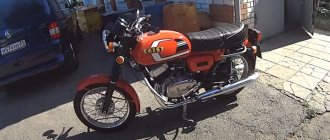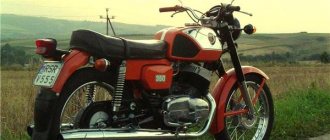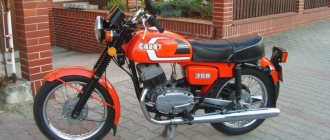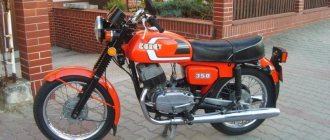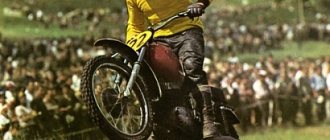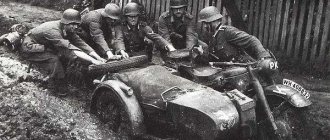This review will focus on a motorcycle that was very popular during the Soviet Union, as well as beyond its borders. The CZ 350 motorcycle (Chezet 350) is a cult bike, which is characterized as reliable transport. The world recognized the Czechoslovakian manufacturer as a reliable supplier of motorcycles, after famous victories in such disciplines as Enduro and Motocross. But, Chezet 350 was rightfully considered a touring motorcycle. It was this unit that made it possible for tourists of that time to discover new horizons.
Production of the CZ 350 type 472.5 began in 1981. The model immediately became relevant among Soviet youth and beyond. This model had noticeable differences from its predecessors, which will be discussed later in the article. The distinctive advantages of the motorcycle are its dynamic performance element and sensitive control system. To appreciate the design of the bike, you need to look at the photo of the Cheset motorcycle. Let's look at the main technical aspects of the motorcycle.
What kind of motorcycles were there in the USSR?
Czechoslovak cars did not differ as strikingly from their direct domestic competitors - the 350 cc Izh Jupiter with an index of -3, -4 or -5, as the Japanese and German cars of that time did from our Volgas and Moskviches. It cannot be said that motorcycles from Czechoslovakia were more modern (we are talking about the Jawa 634 and CZ 472 generations), but the manufacturing culture and concept were somewhat different. Imported equipment was more comfortable - less noise and vibration, smoother operation of controls, the presence of a tachometer (Jawa) and powerful lighting equipment
Reliable, comfortable and dynamic motorcycles from Czechoslovakia were absorbed by the USSR market by almost 100%. Only a small portion of the annual issue went to other countries, where they had to be advertised.
The Jawa and CZ fared better in terms of performance in real conditions: reliable starting, less frequent ignition and carburetor adjustments were required. The power unit provided dynamics that were brighter than those of domestic cars, not because of greater power (“Izh Jupiter” was just more powerful), but due to the more flexible characteristics of the engine.
The stylish and neat instrument panel of the Java changed the minds of those who had previously driven Izhas, Kovrovtsy and Minsks. There was no tachometer on the CZ.
The disadvantages of “Yav” and “Chezetov” were also common and significant, and the main thing is that they were intended primarily for smooth asphalt roads. And the point here is not only in the lower strength of the suspension parts, but also in the characteristics of the power unit. The operating range of engine speeds and transmission ratios are selected in such a way that the motorcycle shows itself to be most dynamic at high engine speeds and at high speeds.
Motorcycle Java 638 Lux
There are also two main modifications of the motorcycle - Lux and Super. They have an additional designation in the name - 000. Accordingly, the Lux modification received a special shock absorber, thanks to which it was possible to ride a motorcycle with a trailer. To make driving this version as comfortable as possible, the manufacturer installed rubber inserts for the knees and a new, more comfortable seat.
The exterior has also been improved, resulting in a different control panel and muffler. The cylinders on the Java Lux are now placed vertically, which saves space on the motorcycle.
Motorcycle CZ 350 (Chezet 350) – detailed review
This review will focus on a motorcycle that was very popular during the Soviet Union, as well as beyond its borders. The CZ 350 motorcycle (Chezet 350) is a cult bike, which is characterized as reliable transport. The world recognized the Czechoslovakian manufacturer as a reliable supplier of motorcycles, after famous victories in such disciplines as Enduro and Motocross. But, Chezet 350 was rightfully considered a touring motorcycle. It was this unit that made it possible for tourists of that time to discover new horizons.
Production of the CZ 350 type 472.5 began in 1981. The model immediately became relevant among Soviet youth and beyond. This model had noticeable differences from its predecessors, which will be discussed later in the article. The distinctive advantages of the motorcycle are its dynamic performance element and sensitive control system. To appreciate the design of the bike, you need to look at the photo of the Cheset motorcycle. Let's look at the main technical aspects of the motorcycle.
The last motorcycle
As you already know, production of this type of transport at the plant was curtailed in 1998. But which model was the last? It turned out to be the Chezet Kagiwa Roadster 125 motocross motorcycle. They began producing it in 1994 and after four years of relative success, production was stopped, and with it the creation of motorcycles in principle.
It is worth noting that it was an impressive model in appearance, and its technical characteristics were excellent. But, probably, the Chesets have already outlived their usefulness, so nothing can be done about it. But many people are still trying to find a Cheset motorcycle, spare parts for it, and so on. Naturally, you can’t officially buy it anywhere, but it’s still quite possible to buy such a motorcycle second-hand.
General information
In addition to the USSR, CZ motorcycles found their audience in other countries of the world, primarily due to their technical characteristics and success in motocross and enduro.
It was on Cesete that the Belgian racer Joël Robbert became the world champion, three times – 1964, 1968 and 1969. Also, the make and model of the motorcycle brought third place in the 1964 world championship to Soviet rider Viktor Arbekov. In 1695, he became the first Soviet world champion in motocross.
The history of CZ
The production of this motorcycle began in 1930 at the Česká zbrojovka plant in the Czech city of Strakonice. Previously, this plant produced weapons that had worldwide popularity, primarily due to the quality of work and service life.
The first motorcycle at the plant was created based on the prototype of the German model DKW NZ 350. The first motorcycle, the CZ 350, appeared in 1930, its main purpose was to ride on difficult terrain and rocks. The CZ 350 became the basis for the creation of more advanced motorcycle models. During the Great Patriotic War, the production of motorcycles at the plant was suspended, and the plant returned to the production of weapons.
But motorcycles produced in the pre-war period began to be actively used in combat operations - they delivered weapons, medicine, and food to the battlefield. According to statistics, out of 500,000 motorcycles involved in military operations, only about 200 were completely damaged. Even today, cars produced in Soviet times continue to fulfill their functional duties. After the end of hostilities, the production of motor vehicles within the walls of the plant resumed.
Motorcycle in the USSR
It is worth noting that the CZ 350 was not supplied en masse to the USSR, like, for example, its sister brand Jawa. This is probably why the CZ 350 had a special “foreign charm” and was highly valued among domestic motorcycle enthusiasts. In the USSR, the most popular were the 350 cc models of the 472 family, which were produced in various modifications from 1976 to 1989.
Unlike Java motorcycles, the CZ-350 was sold exclusively as “single” motorcycles, which further contributed to their popularity among young people. In the second half of the 80s, a new Chezet in a wooden box costs 1050 Soviet rubles.
The demand for Chesets was so high that in search of a new motorcycle, motorcyclists could travel halfway across the country to find their Chesets in some motorcycle or sports store. Today, such rarities can be sold for 1,500 euros, primarily due to the fact that in the Soviet years they were practically not used, they were taken more to show off, rarely when the mileage exceeded 2,000 kilometers.
Review Java 350 638
This model is considered a continuation of the Java 350 634 motorcycle, the characteristics of which can be viewed at the link. The new model featured a more powerful engine and discreet design. In those years it was considered stylish and sporty, so in the 80s the Java 638 was the dream of thousands of people. The new product also differed from its younger brother in the absence of chrome in some parts. This could be explained by the fact that production was cheaper during release. Unfortunately, the 80s were a difficult period for the USSR, so they were unable to expand production and make the model as popular as the Java Old Woman, produced long before the 638 Java.
Current reviews of the Java 638 characterize the motorcycle as a true friend, which has a pleasant appearance, thoughtful details and, unfortunately, their absence on the market. The biggest disadvantage is the current shortage of parts for this model. There are more than enough motorcycle owners, but even finding Java 638 spare parts in an online store is sometimes difficult. Owners also consider spare parts too expensive.
Motor Java 359 638
Unlike other Java models, this new product had an important feature - the Java 638 cylinders were made of aluminum. Thanks to this innovation, the weight of the structure has been significantly reduced, and thanks to the aluminum fins, air cooling has become even better.
The manufacturer has placed great emphasis on the engine, so its characteristics are competitive even today. Unlike its predecessors, this vehicle has surpassed them in all respects in terms of engine performance. At a maximum speed of 5,500 rpm, it had a torque of 31.38 Nm. But having a 2-stroke system has its advantage - the engine has better distribution of exhaust gases, and the fuel mixture distribution system is now even simpler. Also, repairing a 4-stroke engine will be much more difficult. And most importantly, the maximum speed declared by the manufacturer was 120 km/h, but some owners talk about reaching 130 km/h.
Design Java 638
The most important change in the new product was the presence of a front telescopic fork, which its predecessors did not have. Thanks to this, the Java 638 fork allows you to withstand driving both on a flat track and on a road with difficult surfaces. The general appearance of the motorcycle was quite popular at that time - the absence of plastic, a long and voluminous muffler and the ability to reach any part. The seat on the Java 638 was quite comfortable, you could take one passenger.
The manufacturer also took care to change the location of the fuel tank, which, with a volume of 17 liters, received a special fastening. Thus, when driving fast, almost no vibration is heard from the tank.
Motorcycles "Chezet"
It’s worth starting by getting to know the Chezet motorcycle as such. What kind of vehicle is this? In fact, everything is quite simple - these are motorcycles of Czechoslovak and then Czech production, which are called that only in Russia. “Chezet” is rather a nickname, because the original name is Česká zbrojovka Strakonice. Naturally, Russian people do not want to use such a name in their everyday speech, so he decided to simplify everything by shortening the name to indicate the country of production, that is, CZ. Well, then, if you pronounce these letters, then you get “Chezet”.
Of course, this was necessary for dictation. Motorcycle owners, who became a public organization led and represented by the Council, could more easily and quickly solve emerging problems and problems, could expect government support or certain incentives for registering vehicles or organizing the departure of Club members for trips abroad. Finally, the club brought together so-called people with common interests and related goals and interests.
About motorcycles and motorcyclists. Despite the fact that the motorcycle was a rather rare, in modern parlance, an exotic car that expresses a lot of noise and arouses interest, admiration or indignation in the literal and figurative sense, it was necessary not only to buy it, which means it had to be quite rich , or love a lot or stubbornly strive to commit to such completely short-lived, unsuspecting and dangerous “investments”. By the way, you had to be able to drive a motorcycle.
This plant has been operating since 1932 and initially concentrated on the production of mopeds. However, he quickly moved on to motorcycles, and in 1935 the first model appeared. Until 1998, the plant operated, producing a wide variety of motorcycles that became popular in Russia. Which Cheset motorcycle do you remember the most? Which was the first and which was the last?
The tradition of cars in society is just beginning to take shape, so it is natural that the motorcycle was attracted to the eye, and its owners were considered heroes or crazy, but they did not focus. The attention was different and deserved. If you need to learn for a couple of months in a car to learn how to ride, this is considered an excellent five-minute salesman's explanation for riding a motorcycle. An interesting and eloquent detail. The article mentions that "disasters" will begin to rise again in the spring. You hear patterns somewhere, right?
This undoubtedly influenced the development and popularity of the motorcycle, as returnees also used this tried and tested technique, most of them in peacetime. On the other hand, it is necessary to evaluate even before the Great War. The same principles that were valid for the production of cars, tricycles and two-wheelers. Thus, in a relatively short time, as throughout the world, motorcycles have become not only a popular car, but also a form of leisure in our country.
First motorcycle
The very first Cheset motorcycle that was produced at the plant was the CZ 175, which was born in 1935. It was a simple classic motorcycle that immediately attracted a lot of attention. As a result, its improved model was produced for the next two years, which was then replaced by a new one. However, it was the 175 that was remembered as the first and very interesting motorcycle; it was used throughout the Czech Republic and was also supplied abroad.
Data also comes from the nation's 25 largest cities and counties. The list recorded that 36 motorcycles were registered in Lithuania this year. An impressive number, even considering that the motorcycle is also referred to as other two-wheeled vehicles, which, according to today's understanding of motorcycles, can correspond to the concept of "motor scooter" or "motorcycle". However, the variety is surprising and amazing.
Looking at all 36 manufacturers listed, some trends can be seen. Although the Americans - Harley Davidson and the Indian and British Douglas - were firmly established at the top of the table, most motorcycles were made by European manufacturers.
Needless to say, after production ended in 1937, this model was revived and updated in 1957 to be produced in several different trim levels over the next 12 years, and then periodically add new types until almost the end of production. This is not at all like the Chezet 350 motorcycle, which was produced only for two years. This model turned out to be very popular.
All organizations registered at the time of the census were required to complete questionnaires specifically completed for this purpose, which stated that the data collected for statistical purposes and answered as accurately as possible. The organization's board or other respondents who refuse to provide knowledge may be subject to criminal prosecution under the Criminal Code. Holy Article 139.
In the form of this survey, the requested questionnaire data are: the address of the headquarters of the organization, the date of foundation and the name of the purposes provided for in the charters, please indicate the nationality and faith of your actual members and the list below. Another interesting detail of this census was that along with citizenship it was necessary to indicate the religion of the true members of the organization. When meeting this requirement, the questionnaire states that: Catholic Right - 42, Evangelicals - 10, Other Christians - 3, Israelis.
Cheset 350: technical characteristics
The main power plant is a two-stroke engine with 2 cylinders. The cylinder arrangement is in-line. The working volume is 343 cc. At the same time, the motor is capable of producing 22 hp. The Port control function was used as a distribution system. The engine receives the necessary cooling due to the oncoming air flow.
The transmission consists of 4 gears. The main transmission is a metal chain. Drum brakes are installed at the front and rear of the motorcycle. Front and rear wheel sizes respectively: 3.25-18 and 3.50-18. The fuel tank is designed for 18 liters of fuel. The motorcycle is capable of reaching a maximum speed of 125 km/h.
Main differences from previous models
- Spacious fuel tank.
- Upgraded telescopic forks at the front (with black boots).
- Installed safety bars.
- Improved seat.
- Large headlight.
Models type 472.3 and 472.4 were equipped with small-volume gas tanks, which caused a lot of outrage among buyers. These tanks were suitable for sports motorcycles, but not for touring ones. From an ergonomic point of view, the shape of the tank was also unsuitable. The rear part of the tank was wide and caused inconvenience to the owner of the equipment in operation. The upgraded gas tank is designed for 18 liters of gasoline. Its shape has been changed, making travel more comfortable. Regardless of the driver’s configuration, sitting on the motorcycle does not cause discomfort.
Don’t forget about the telescopic fork at the front, which has undergone some changes. The lower pipes are made of light alloy, which in turn only had a positive effect on the price of the fork. Regardless of the operating conditions of the motorcycle, the fork works well both on small uneven surfaces and deep holes, bumps and potholes. In addition, travel has become safer. The fact is that it is very difficult to bring the fork to the bottom, dead-end position. Well, let us remind you about the new rubber covers on the fork, which prevent dust from getting into the middle of the fork. Due to this, the fork will serve for many years.
Description of the classic motorcycle Chezet 350
The first motorcycles appeared in 1930. It was developed by specialists from the city of Czechoslovakia.
This motorcycle was first released from the CZ factory, at that time weapons were manufactured there.
In 1932, the first motorbike was created, which was equipped with a 76 cm3 engine.
In 1933, a cross-country model was released. A 100 cm3 engine was used. After this model, a motorcycle was developed, which was equipped with a 3-speed gearbox and an engine (175 cm3).
In 1936 with 250 cm3. From this model, 2 models were created: - 2 - x cylinder unit with 500 cm3; — 1 — cylinder with 350 cm3.
After the war ended, the production of Cezet motorcycles was resumed. They were produced with a telescopic front fork.
Later a version with rear spark plug suspension was used. In 1950 The production of motorcycles from this company was established.
They were equipped with 2-stroke engines with 123 and 148 cm3. From 1962 to 1965 Java and Chiset were sold on the USSR market. They were very popular at that time.
In 1990, the plant was bought by the Italians. Road motorcycles of 2 types began to be produced: - 2-stroke with 124 cm3 with a Cagiva engine; — 4-stroke with 200 cm3 with CZ engine.
History of the enterprise [edit | edit code]
The small arms production plant in Strakonice was built in 1919 and was originally called Jihočeská zbrojovka
(South Bohemian Arms Factory).
In 1922, through a merger with other similar enterprises, the joint stock company Česká zbrojovka v Praze továrny ve Strakonicích
(Czech Arms Factory in Prague, enterprise in Strakonice) was created.
The company's trademark is the abbreviation CZ
(CheZet).
In the mid-1920s, the company began to develop civilian products, in particular bicycles. In 1929, the first motorbike with a 76 cm³ engine was released, nicknamed Kaktus for its characteristic cylinder shape [3].
Specifications
| dry weight | 158 kg |
| with the liquid used | 171 kg |
| lifting capacity | 160 kg |
| engine capacity | 343.3 cm3 |
| bore/stroke | 58*65 |
| working engine power | 23 hp/5250 rpm |
| cooling system | air |
| compression | 1*9* 2 |
| engine | 2-stroke |
| carburetor | Jikov 2926 SBD |
| maximum speed | 132 km/h |
| consumption | 4.7 liters/100 km |
| fuel tank | 13 l |
| oil for box | 1.2 l |
| front fork oils | 0.2 l |
| Motorcycle dimensions | |
| length | 201 cm |
| height | 101 cm |
| width | 71.5 cm |
| transmission | 4 speed |
| brake system | drum |
Modern edition
The modern production of CheZet motorcycles is very diverse. You can purchase a sports or classic type of motorcycle.
These models are produced for driving: amateur and professional.
These motorcycles are made using motors that have increased power and torque. Light weight. You can create fast dynamics during acceleration.
The classic version of CheZet motorcycles is considered to be a model with an engine capacity of 350 cm3. In terms of technical characteristics, these motorcycles are similar to Java motorcycles.
Therefore, many parts of these two brands of motorcycles are interchangeable. In 1973, these 2 companies merged to jointly release.
The most popular and best-selling model of the CheZet motorcycle is the CZ (CheZet) 350 12v.
This model belongs to the tourist class. 23 hp motor. With. A 4-speed gearbox is used. The engine speed is squeezed to the maximum - 5000 rpm.
approximate cost
It is very difficult to talk about a specific price for this device. Everything depends primarily on the condition of the frame and the technical condition of the bike; we must not forget about the availability of all the necessary documents. On the Russian market, the price for this model starts from 10,000 rubles. Motorcycles sold are as early as 1988 or older.
An inspiring video of a Triumph motorcycle; when watching, you can feel the reliability and power of this bike.
A modular helmet for a snowmobile has undeniable advantages for use in winter.
Motorcycles for every taste and budget
Regardless of your purchasing goals and preferences, in our ad service you can purchase:
- used and new motorcycles;
- bright and fast racing models;
- timeless classics from Harley Davidson;
- “workhorses” - cargo motorcycles and models with sidecars;
- Soviet motorcycles - both with a fair amount of mileage and after garage storage.
Advertisements are placed by individuals and business representatives, but prices for OLH in any case are much more pleasant than in car dealerships.
Photo gallery
Introducing the iconic CZ 350, a true legend of its time. There wasn't a single teenager who didn't want to buy this bike. We have made a small selection of photographs especially for you.
